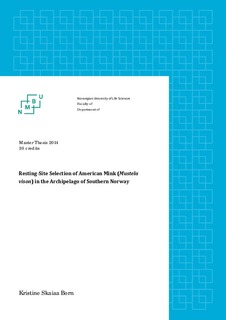| dc.description.abstract | The American mink (Mustela vison) was introduced to European countries in the 1920’s, from individuals escaping from fur farms. In Norway, minks are now common throughout the country. This invasive species can cause habitat shifts, reduced breeding success or extinction in colonies of ground nesting or early breeding birds. In Oksøy-Ryvingen special landscape area in Vest-Agder, southern Norway, a mink project has been initiated. The goal the project is to have the bird protection areas free of mink at the start of the birds' breeding season. In my thesis, I have analyzed the minks’ preference of resting site characteristics in this area, by comparing resting sites with random plots. Information on resting site selection in mink was obtained by hunting during 2 winters (2012/13 and 2013/14) and resulted in 84 observations, which were compared with 62 random plots collected in the same area. The model that best explained the resting site characteristics preferred by minks was found by using logistic regression. The dominating vegetation type on islands was the variable explaining most of minks' resting site preferences. Most minks were found on islands dominated by shrubs like heather and juniper, which may give shelter from predation, good access to prey and some protection against wind and weather. A preference for islands without rough grazing was also found. Minks were most likely found in a boulder pile, or under a stone, in a slope or on a flat less than 25 meters from the ocean. The selected resting site structures provide both insulation and protection from predation. The study also showed that minks prefer resting sites with low wind exposure. The results from this study may contribute to more efficient management of mink populations. Changes in vegetation, placement of traps in proximity to possible resting sites and more efficient search for mink can be recommended management tools from this thesis. | nb_NO |

